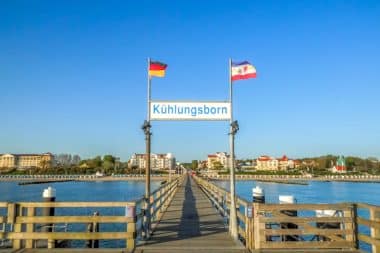The bathing and recreation resort of Kühlungsborn is located on the Mecklenburg Bay in the district of Rostock in Mecklenburg-Vorpommern, Germany. It is the largest seaside resort on the Baltic Sea coast of Mecklenburg.
The romantic Baltic Sea resort awakens from its slumber
Because of its extensive city forest, the place is nicknamed the Green City by the Sea. To the south of the city rises the wooded Kühlung mountain range. North of Kägsdorf on the Baltic Sea lies the 90-hectare Riedensee nature reserve. The landscape of the beach lake forms a habitat and breeding ground for rare birds. But above all, the inviting, wide and fine sandy beach makes Kühlungsborn a popular holiday resort. Around 1900, the first hotels were built in the then still independent municipalities of Brunshaupten and Arendsee.
Within a few years, they developed into lively seaside resorts until the First World War and the Great Depression led to a slump. It was not until the 1920s that increasing numbers of guests allowed a further expansion of the tourist infrastructure. In 1937, the two villages were merged to form the municipality of Brunshaupten-Arendsee. In 1938, the Baltic Sea resort was granted city rights under the name Kühlungsborn. In the days of the GDR, the still popular and well-visited place was largely under state control.
After its eventful past, Kühlungsborn at the northernmost tip of Mecklenburg now shines again with the same charm as the romantic seaside resorts of the turn of the century. In the meantime, the old villas in the style of spa architecture and the waterfront promenade have been lovingly restored and the city has received a new boat harbour. With exhibits from the region, the Heimatstube Haus Rolle presents the history of the city in a vivid way for visitors.
The historic seaside resort has a lot to offer its guests

The harbour promenade of Kühlungsborn is one of the longest beach promenades in Germany. Over a length of more than three kilometres, it offers a fascinating view of the Baltic Sea and the white beach. In front of the enchanting silhouette of the seaside resort, it invites you to take a stroll. At the eastern end of the beach is the impressive pier, the town’s landmark. It was completed in 1991 after some of its predecessors had fallen victim to the harsh winter weather. A popular shopping street for strolling is Strandstraße, a cross street of the beach promenade. The adjacent marina with its numerous harbour terraces is also home to boutiques, shops and restaurants.
Not far from the bridge stands a former border tower with a viewing platform, which now serves as a memorial. It has been open to visitors since 2010. The exhibition in the museum pavilion informs interested parties about the border system of the GDR. The Kunsthalle of Kühlungsborn is also picturesquely located on the Baltic Sea coast. The Art Nouveau Hall from 1920 hosts readings, concerts and exhibitions.
The village and the surrounding area are home to a large number of monuments worth seeing. The St. John’s Church, originally a simple fieldstone church from the 13th century, has been steadily expanded over time. Towards the end of the 15th century, it received its wooden tower. Above all, the beautiful furnishings with baroque stained glass in the choir windows and carved figures, including John the Baptist, are remarkable. An old Erdholländer mill, the 150-year-old Brunshöver Möhl windmill, ground the grain for the surrounding villages until 1960. Afterwards, it stood empty for a long time. After an extensive renovation in 1987, it now houses holiday accommodation.
On the Bukspitze headland on the Mecklenburg Bay stands the Buk lighthouse, sometimes also called Basdorf lighthouse, which can be seen from afar. From the tower, built in 1867, you can enjoy a beautiful view of the island of Fehmarn and some of the Danish islands in good weather. Molli, the oldest steam narrow-gauge railway on the Baltic Sea coast, has been connecting Bad Doberan with Heiligendamm and the Baltic Sea resort of Kühlungsborn since 1886. It still makes its way through the middle of Bad Doberan’s main shopping street, whistling and steaming. The Molli Museum vividly presents the history of the railway.
Kühlungsborn offers a wide range of opportunities for sports, games and fun
In the city forest, a few meters from the beach, there is the climbing forest. The brave adventurers are provided with the necessary equipment and trained staff instructs them in the courses of varying difficulty. In addition, numerous adventure playgrounds guarantee variety for families with children.
Sports activities in the fresh air can be practiced on the two sports beaches of Kühlungsborn. The Aktiv Fun Strand is located between the pier and the boat harbour and the Vital Fit Strand is located in the west of Kühlungsborn. Fantastic cycling and hiking tours lead through the charming landscape of the Mecklenburg Baltic Sea coast. On the enchanting beach you can swim or relax in a beach chair. In addition, seawater pools and a large sauna area await their bathers in the KÜBOMARE indoor swimming pool. There is something for every taste in Kühlungsborn, such as water sports, horseback riding or fishing.
A gentle sea breeze and the white dream beach make Kühlungsborn a seaside resort with flair
In the beautiful nature of the surrounding area or during an evening walk on the Baltic Sea beach, holidaymakers will find rest and relaxation. There are plenty of culinary delights to discover, including freshly caught fish straight from the cutter and cosy restaurants on the beach. You can enjoy unique culture in the open air in one of the concert gardens at a concert or in the puppet theatre. Unusual entertainment is offered by the beach chair cinema. Whether camping, holiday apartment or a stylish hotel, those seeking relaxation can easily find the right accommodation in Kühlungsborn.


